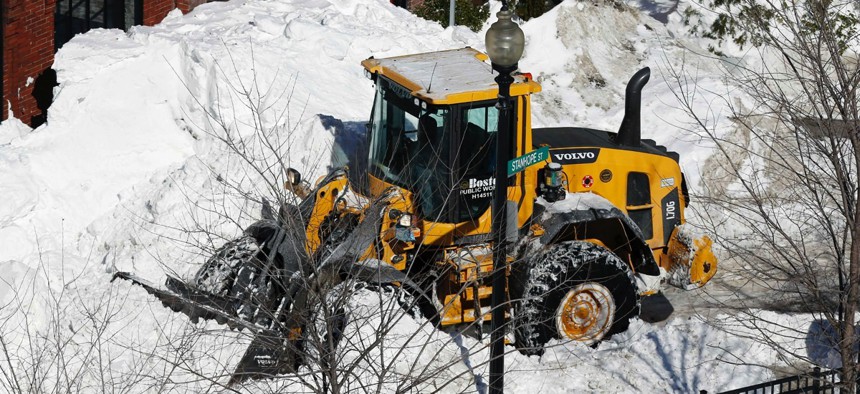Massachusetts Cities and Towns Still Feeling Fiscal Hit From Costly Winter

A Boston street on Monday, Feb. 16, 2015 Michael Dwyer / AP Photo
A new credit outlook: “[T]he full effect across all municipalities is significant because it eats into funding for other services or results in declining reserves.”
The record levels of snow might be gone from the ground in Massachusetts, but for some local governments in the state, the financial fallout from last winter’s storms has yet to melt.
On April 13, President Obama signed a disaster declaration which will allow federal aid to flow to the Bay State. The money is meant to help cover costs caused by severe weather that occurred between Jan. 26 and Jan. 28.
But the level of aid the declaration makes available is far lower than the amount Massachusetts Gov. Charlie Baker had initially sought.
The narrow scope of the disaster declaration caught the attention of analysts at Moody’s Investors Service in a credit outlook issued on Monday. The outlook said that the amount of disaster aid available under the declaration had “credit negative” implications for local governments still digging out from last winter’s snow and ice removal cost deficits.
“Although the financial effect is small relative to budget drivers such as education and employee benefits, the full effect across all municipalities is significant because it eats into funding for other services or results in declining reserves,” the credit outlook said.
In the request for a Major Disaster Declaration that he submitted on March 27 to President Obama through the Federal Emergency Management Agency, Gov. Baker said that Massachusetts state and local governments incurred nearly $400 million of costs as a result of the winter weather that hammered the state over 28 days during January and February.
Baker said in the request that snow removal costs during the successive snowfalls totaled $350 million, and asked that the federal government to reimburse these costs at a rate of at least 75 percent. The request said it snowed nearly nine feet in some parts of central and eastern Massachusetts during during the 28-day period.
According to the Massachusetts Municipal Association, Baker said at a news conference last week that the costs tied to the Jan. 26-28 storm, which would qualify for disaster relief under the disaster declaration Obama signed, were likely between $80 million and $90 million. Based on those figures, the amount of federal aid available to the state could be as much as approximately $67.5 million.
The Moody’s outlook pointed to six localities in Massachusetts that exceeded their 2015 snow removal budgets by degrees ranging from 165 percent to 588 percent.
Boston, for instance, had $18.5 million in its 2015 snow removal budget. But actual costs totaled $26.5 million more than that, checking in at $45 million, according to Moody’s. Meanwhile, Fall River, a city with a population of 89,000 residents located about 50 miles south of Boston, racked up $3 million in snow removal costs, but only had $530,000 budgeted, the Moody's outlook said.
The Moody’s analysts said that most municipalities, including big cities like Boston, would be able to make up for snow removal budget deficits with current-year revenues, spending changes, or dipping into reserve accounts. But they also noted that places like Fall River are more “fiscally constrained” and would likely choose to amortize snow removal deficits from last winter, paying them off over several years.
After surveying 217 communities, the Massachusetts Municipal Association estimated late last month that the 351 cities and towns in the state had spent a total of $251 million on snow and ice removal in fiscal 2015 through March 1. This is about $50 million more than those jurisdictions spent on snow removal during the previous year.
Though last winter’s snowfall was unprecedented for the state, it was not the first time towns and cities in Massachusetts outspent their snow removal budgets.

*The figures in the chart do not factor in state or federal reimbursements.
Between 2005 and 2014, the total amount of money that the 351 jurisdictions reported spending on snow removal was only within the bounds of the total amount budgeted during one year, 2012. That’s according to data maintained by the Massachusetts Department of Revenue Division of Local Services.
In every year other than 2012 during that time period, spending outstripped budgeted funds by amounts ranging from $12,101,792 to $133,371,842.
NEXT STORY: Bloomberg investing $42 million to open local data






